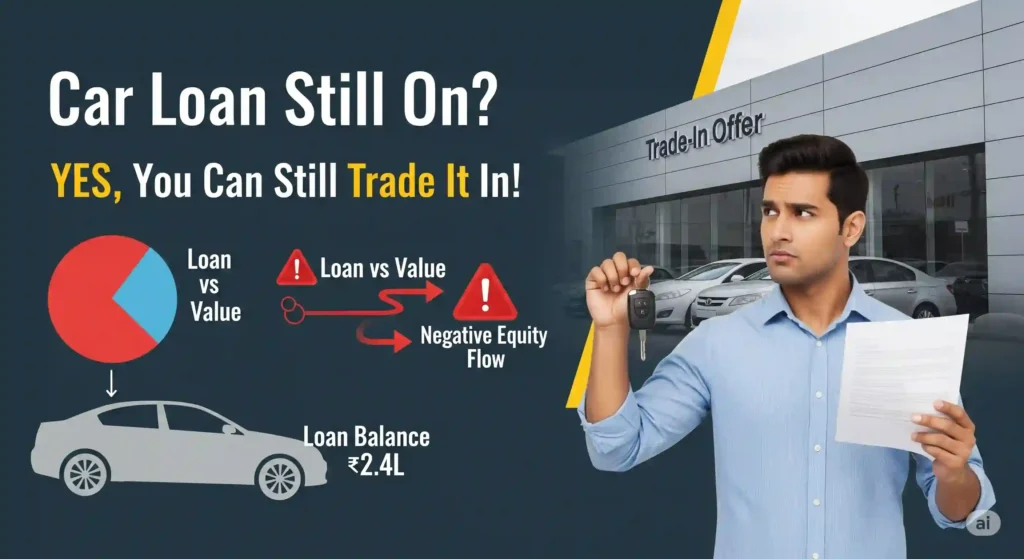Trading in your car can be tricky when there’s still a loan balance—but it’s entirely possible if you understand the math and the paperwork. Whether you’re upgrading to a new ride or switching to a more fuel-efficient option, knowing the ins and outs of trading in a financed car can help you avoid costly mistakes.
This guide breaks down everything you need to know about how to trade in a financed car, including the car loan trade-in process, what happens with negative equity, and how to ensure you get a fair deal at the dealership.
Step-by-Step: How to Trade in a Car You Still Owe Money On
Yes, you can trade in a financed car—but first, you need to determine one thing: do you have positive or negative equity?
- Find out your loan payoff amount: Contact your lender to get the current loan payoff, including any fees or interest.
- Determine your car’s trade-in value: Use platforms like Kelley Blue Book (KBB), Edmunds, or dealer appraisals to estimate your car’s value.
- Calculate equity:
- Positive Equity: If your car’s value is higher than what you owe, you’re in a good position.
- Negative Equity: If your loan balance is higher than your car’s value, you’ll need to pay the difference—or roll it into your next loan (not always recommended).
| Car Value | Loan Payoff | Equity |
|---|---|---|
| ₹8,00,000 | ₹6,50,000 | ₹1,50,000 (Positive) |
| ₹6,00,000 | ₹7,00,000 | ₹-1,00,000 (Negative) |
Once you know where you stand, here’s how the car dealership loan payoff process works:
- The dealer pays your lender directly for the car.
- If you have positive equity, it reduces the cost of your next car.
- If you have negative equity, you may be asked to pay the difference upfront or roll it into a new loan (also called an upside-down loan).
What Happens If You Have Negative Equity?
Having negative equity—also known as being “underwater” on your loan—doesn’t disqualify you from trading in your car, but it does complicate things.
Your options:
- Pay the difference in cash: Best way to avoid rolling debt forward.
- Roll over the debt: Add the difference to your next car loan (higher risk, higher cost).
- Refinance first: If rates are favorable, refinancing might reduce your loan balance before trade-in.
- Sell privately: You may get a better price than a dealership offer.
💡 Pro Tip: If you owe more than your car is worth, consider selling it privately or paying down more of the loan before trading in. You’ll reduce the risk of starting your new loan already in the red.
Can You Trade In a Car for a Lease?
Yes—you can trade in a financed car for a lease, but the same equity rules apply.
- If you have positive equity, it can be used as a capital cost reduction, lowering your lease payments.
- If you have negative equity, the dealer may allow you to roll it into the lease—but beware: this could make your lease more expensive without building any asset.
Industry experts recommend running the numbers before committing:
“Rolling negative equity into a lease may sound attractive, but it often leads to higher monthly payments without ownership,” says Ankit Jain, an auto finance analyst at Lendingkart.
Tips to Avoid a Bad Trade-In Deal
Trading in a financed car doesn’t mean you have to settle for a bad deal. Follow these strategies:
- Get multiple appraisals: Don’t rely on just one dealership’s valuation.
- Negotiate trade-in and purchase separately: Dealers may combine both deals to mask a lowball offer.
- Avoid rolling over large balances: It can trap you in a cycle of negative equity.
- Understand all fees and taxes: Know the full breakdown before signing.
FAQs: What You Should Know Before Trading In
Q: Can I trade in a car that’s not fully paid off?
A: Yes, as long as your lender allows it and the dealership agrees to handle the payoff amount.
Q: What if the dealership pays less than my loan?
A: You’ll either need to pay the difference out-of-pocket or roll it into your new loan or lease—though this increases future financial burden.
Q: Is it smart to roll over my old loan into a new one?
A: Not usually. Rolling over debt can lead to owing more than your car is worth again. It’s best to reduce or eliminate negative equity before making a trade.
Final Thoughts: Weigh Your Options Carefully
Trading in a financed car is doable—but only if you understand your financial standing. Having positive equity gives you control over your financial decisions, while negative equity demands strategic planning.. Whether you’re moving into a new purchase or leasing, ensure the math works in your favor.
Considering a car trade-in? Use an online loan balance vs. trade value calculator to check your equity—and walk into the dealership fully informed.
By following the steps outlined above, you can confidently trade in your financed car without losing money—or getting trapped in an unfavorable deal.
This post is for informational purposes only.Invest responsibly.No guarantees of results. Seek professional guidance before investing.Consult experts for personalized advice.AI-assisted content, editorially reviewed.See our terms for details.Please note that I am not a SEBI registered investment advisor. The information provided in this article is for informational and educational purposes only and should not be construed as financial advice. Always consult with a qualified and SEBI registered financial professional before making any investment decisions. .Follows Google policies.Not affiliated with Investopedia.com. investopedia.co.in Independent site.
